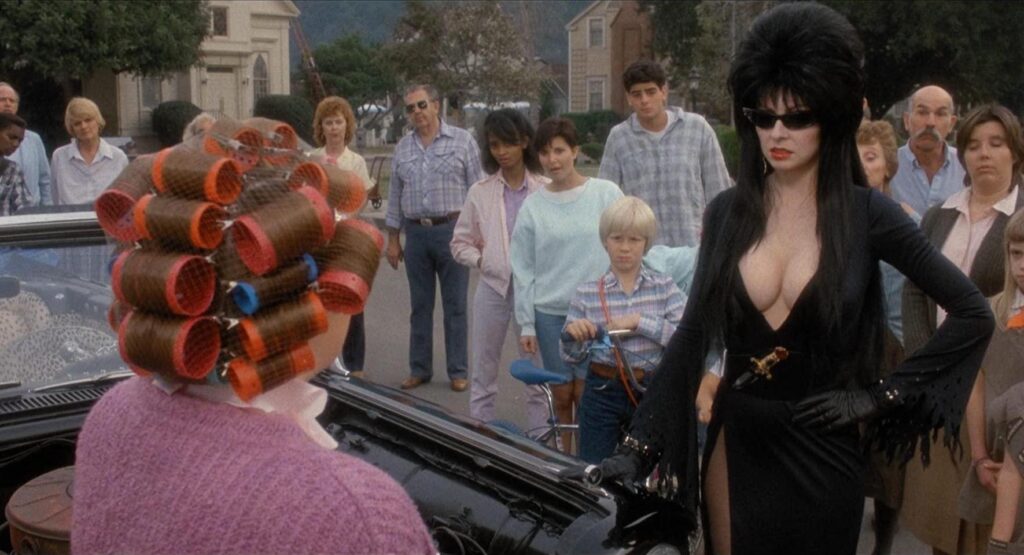
You couldn’t grow up in the eighties and nineties without knowing who Elvira/Cassandra Peterson was. Elvira’s Movie Macabre (1981-86) was a staple for five years and introduced a generation to the classic B-movie horror pictures of the thirties, forties, fifties, and early sixties. Elvira’s Maila Nurmi inspired buxom visage adorned posters, pin-ups, toys and all manner of commercial tie-ins for years as the face of all that is spooky, sexy and fun in American popular culture. More than her beauty audiences connected with Peterson’s Elvira character because of her humor. Elvira’s sassy, corny, and sometimes scathing in her summing up of old horror pictures. This humorous demeanor made Elvira a person you wanted to know because she understood why old horror films are just so much fun, even when they’re bad.
The draw of Elvira: Mistress Of The Dark (1988) was to see this person, this TV host, in her “real” life. The film opens with a taping session wrapping in the studio when a series of events unfolds that results in Elvira quitting her hosting gig. If television is Elvira’s job, then the cinema is her life. The character is presented in a totally different context in the film. In the film Elvira goes to different places, has family, owns a car, and has to interact with the annoying sorts of people that we, the audience, must encounter every single day. Elvira’s Movie Macabre brought the ultimate scream queen into America’s homes while Elvira: Mistress Of The Dark took audiences to the theaters to visit Elvira’s home.
The life Elvira leads outside of hosting horror movies on late night television is, of course, a pastiche of those very same films. Who better than Roger Corman’s New World Pictures to bring this macabre comedy to the screen? Elvira: Mistress Of The Dark is a reflexive, ironic, and wacky tale about acceptance. The film plays with the same tongue in cheek sentimentality as the hot rod drive in movies of the late fifties. After quitting her job Elvira discovers that, to her surprise, she had a sorceress for an aunt who very recently passed away. Soon Elvira is on the road to a small New England town to claim her inheritance to finance her own Las Vegas show.
The image of Elvira is more than it seems. Those unfamiliar with the show or the film tend to view the character as something of a bimbo. The “look” of Elvira clearly is designed with the male gaze in mind but Cassandra Peterson’s performance expands upon and subverts that type. In the first few minutes of Elvira: Mistress Of The Dark Elvira wraps her show, is introduced on set to the network’s new owner and is groped by this rotund Texan. Elvira’s response is to slug the jerk in the jaw, denounce him for what he is on live television and resign. This immediately establishes her “look” as her choice as well as revealing that our culture, patriarchal and capitalist, views her attire as a sign of female commodification.
Beneath the surface of her appearance and the assumptions some people and characters in the film make about Elvira she is independent, tough, sassy, horny, sarcastic, and totally comfortable with who she is. This is why the townsfolk despise her so much. Her 80s Goth chic appearance and outward sexuality unhinge their fifties notion of American decency. Long before the film gets around to revealing she’s a witch the town, with the exception of Bob (Daniel Greene), is aligned against her. As silly as the movie is Elvira’s persistence in retaining her individuality in the face of overwhelming oppression and slut shaming is empowering; her dog, her car, her hair, her dress, etc. all assert her identity. So it’s little wonder that she’s a favorite amongst drag acts and in queer culture in general. This empowerment proves contagious within the narrative of the film as well as long repressed teenagers come flocking to aid Elvria à la The Music Man (1962).
Even as the townsfolk prepare to burn her at the stake the real villain, her warlock uncle (W. Morgan Sheppard), is about to make his move. Once Elvira uses her magic ring to escape a fiery death a wizard’s duel commences between Elvira and her uncle. The special effects and hammy quips recall the climactic battle in Corman’s own The Raven (1963). Needless to say that, with the help of some fatal slapstick, Elvira triumphs, inherits her uncles estate, gains acceptance in the town, finances her show and ends the movie with a lavish burlesque number.
Apart from starring in the film Cassandra Peterson also co-wrote the screenplay. Elvira: Mistress Of The Dark is her film. With a touch of irony the character of Elvira ends the movie in the city where Peterson first made it as a dancer in the early seventies. Even the “otherness” that Elvira represents could be taken as a coded representation of Peterson’s own (at the time) closeted homosexuality, particularly since Elvira’s aggressive sexual behavior is performed in true burlesque fashion in broad strokes.
Peterson’s vision of her character off of the small screen of television is greatly aided by the direction of James Signorelli. Like Peterson, Signorelli worked mostly for television though as a director rather than a performer. He’s responsible for hundreds of Saturday Night Live sketches and brings that excellent sense for comedic timing to Elvira: Mistress Of The Dark.
Elvira: Mistress Of The Dark is one of the great Halloween movies. There are few films that evoke this spooky season so well and manage to be so much goofy fun as this one does. Since it first came to home video on VHS Elvira: Mistress Of The Dark has been a favorite for Halloween parties, the down time when passing out candy, or just for cuddling with a partner or pet. It’s a classic.
